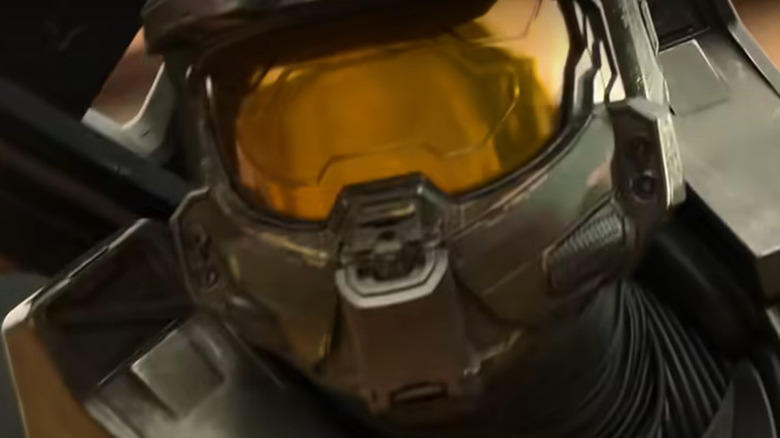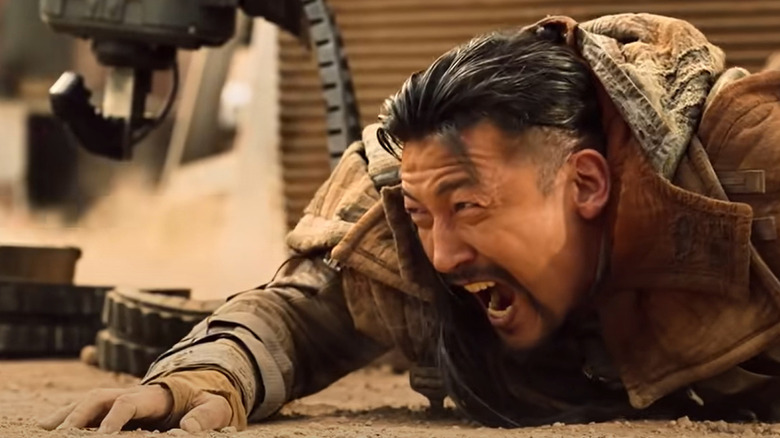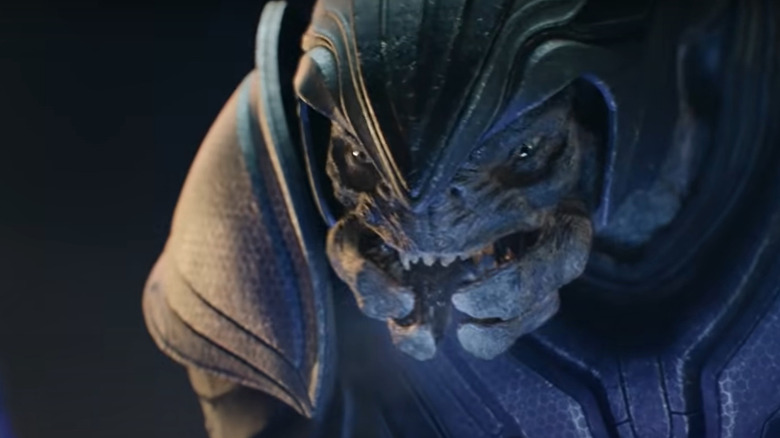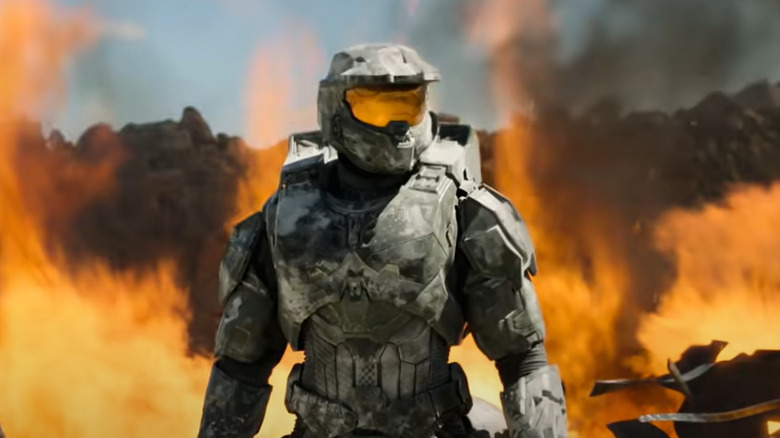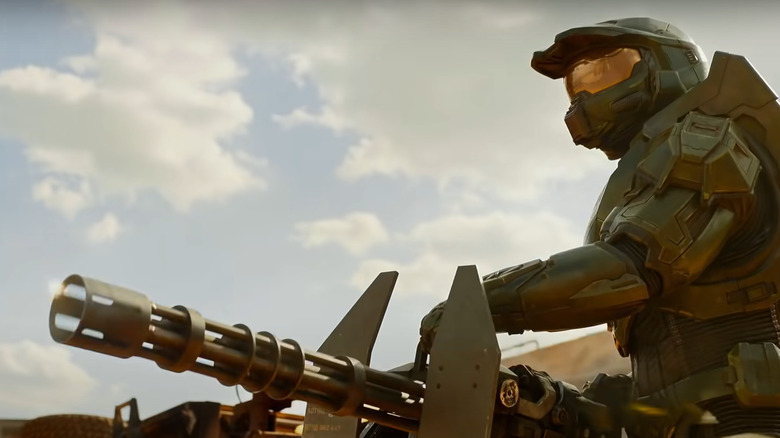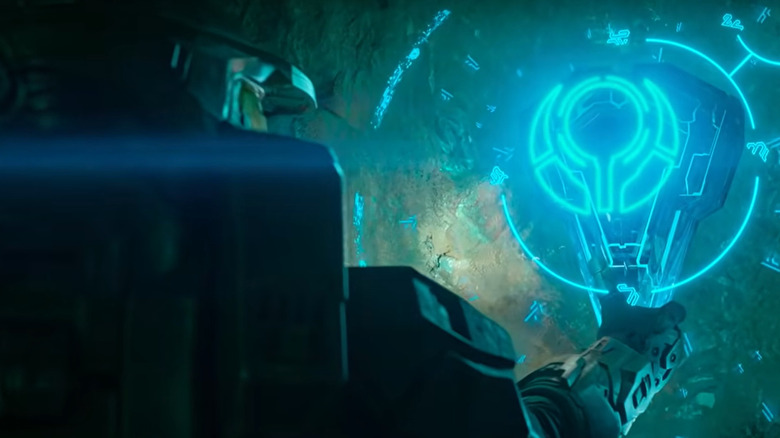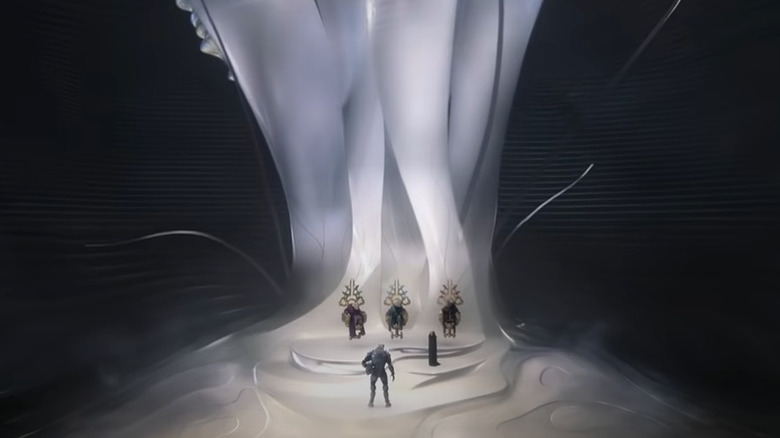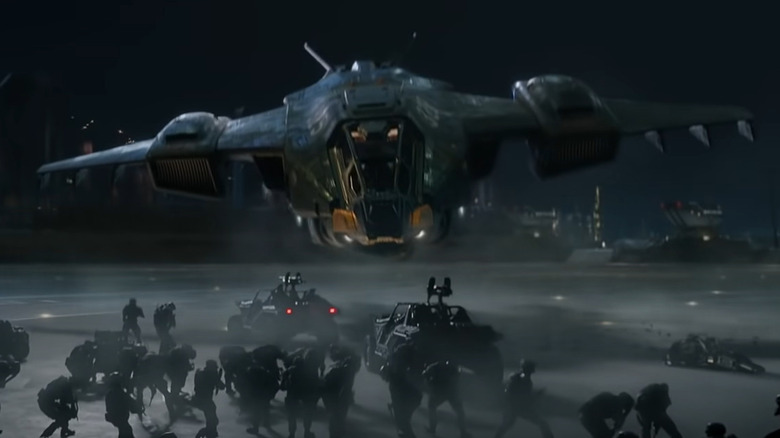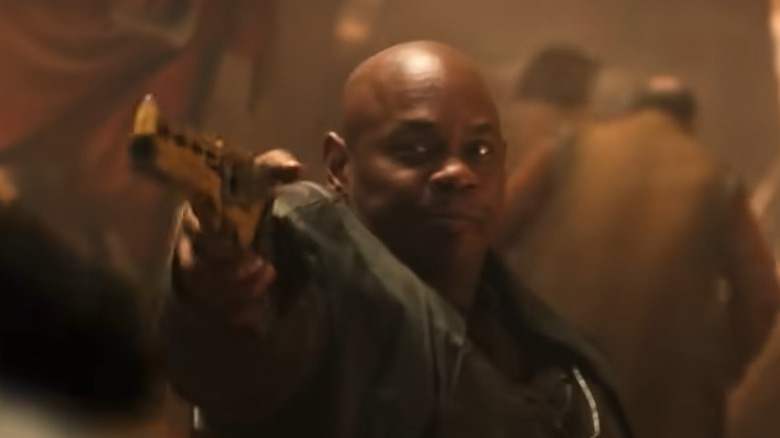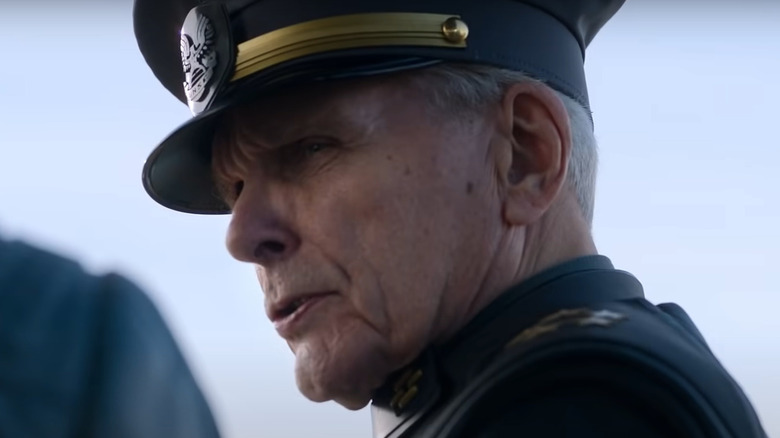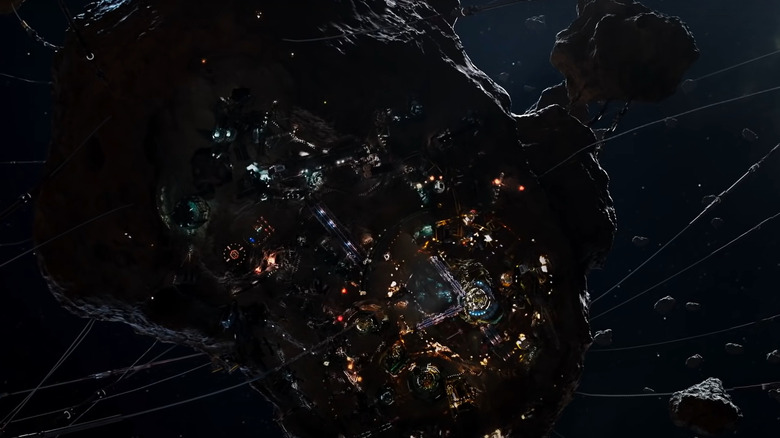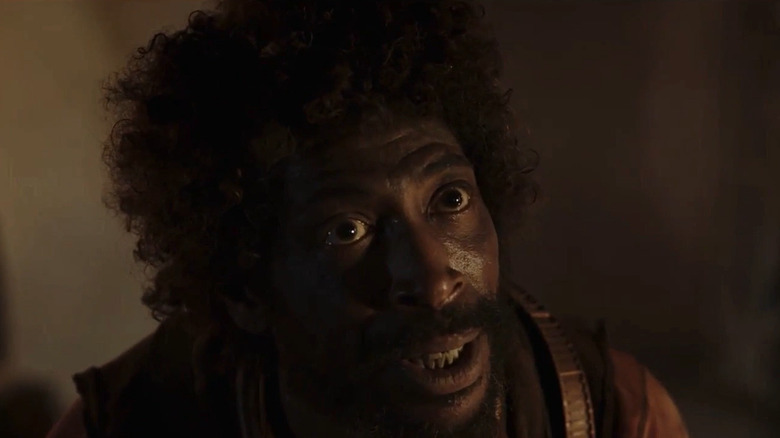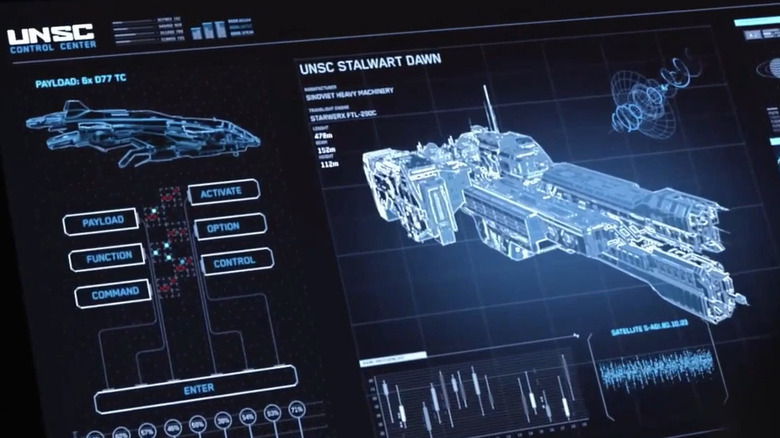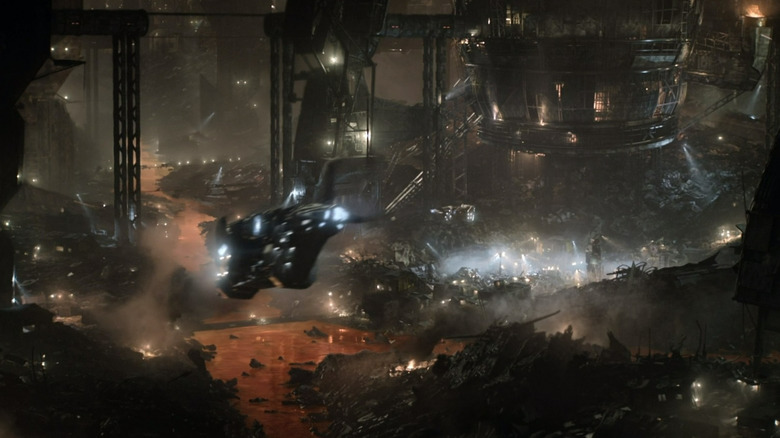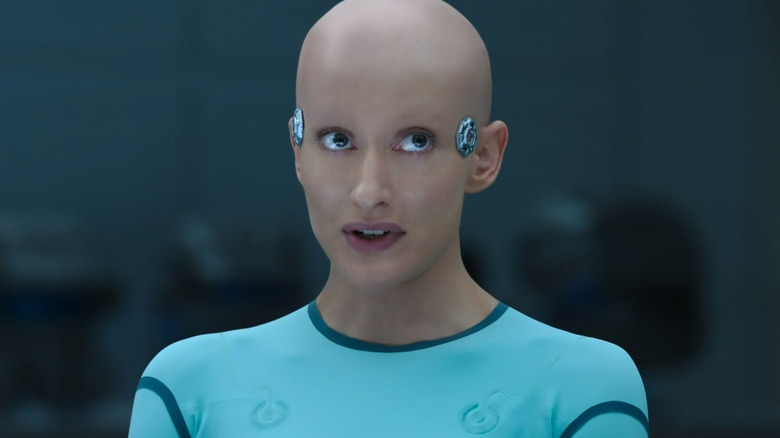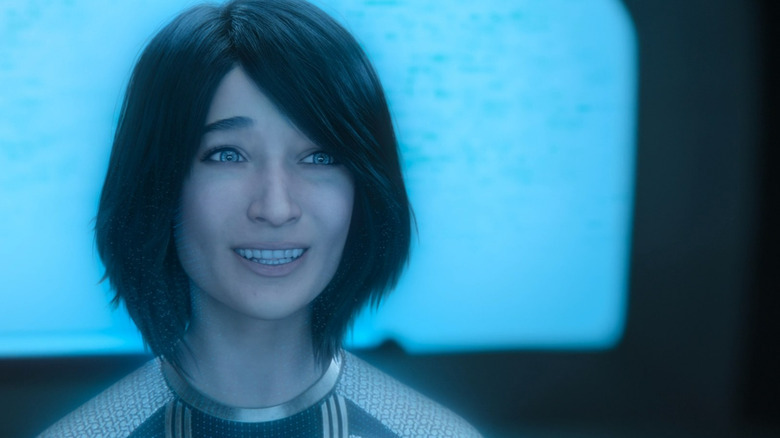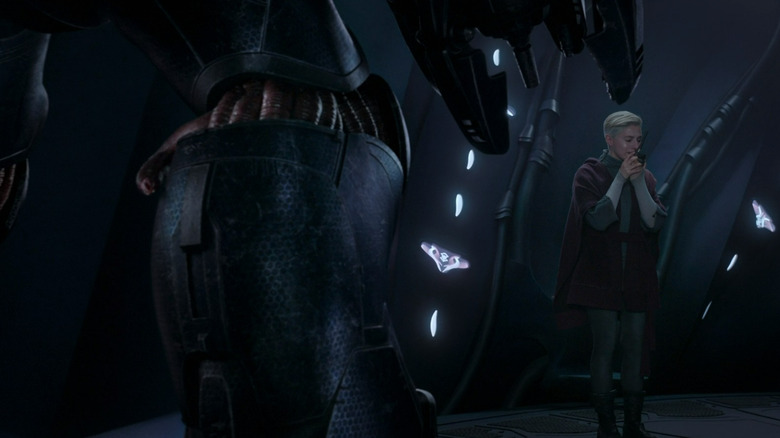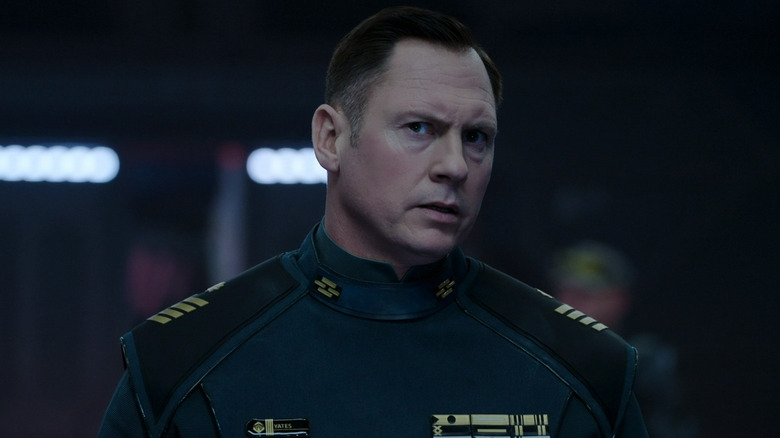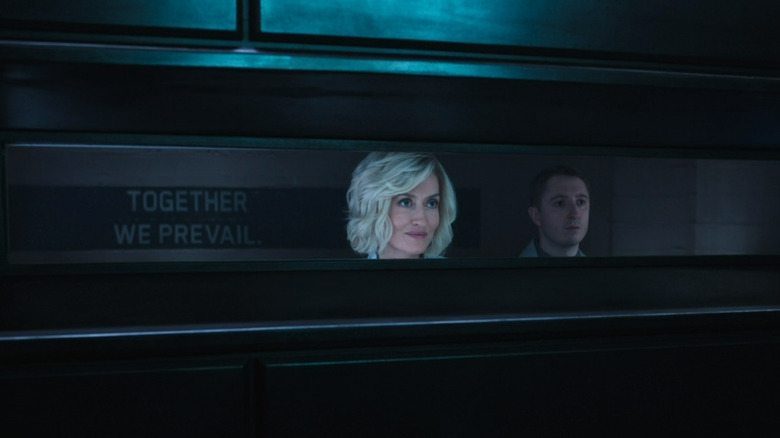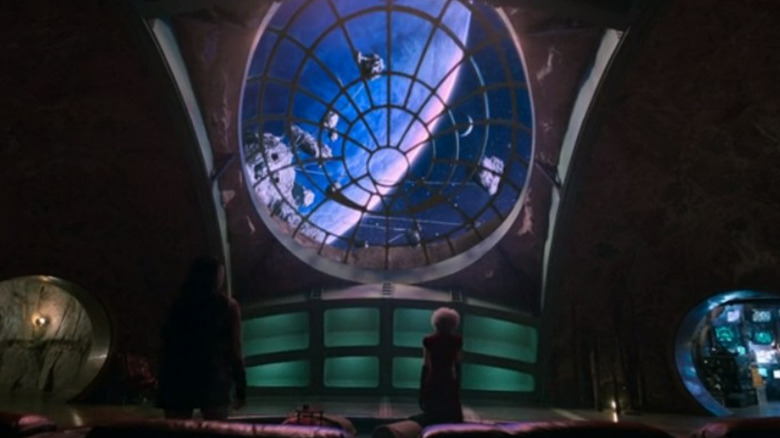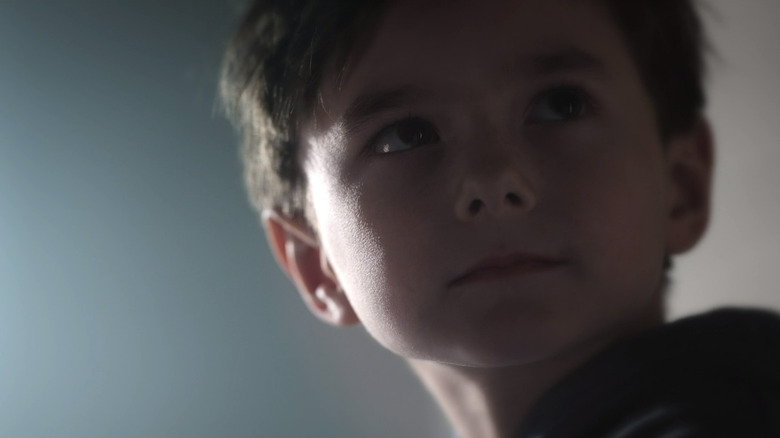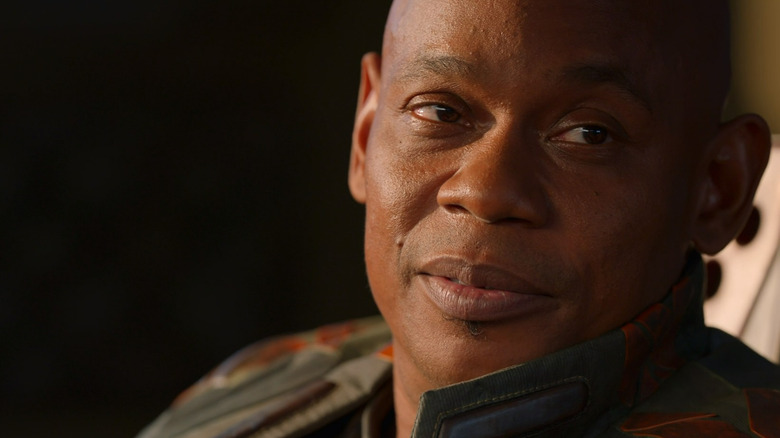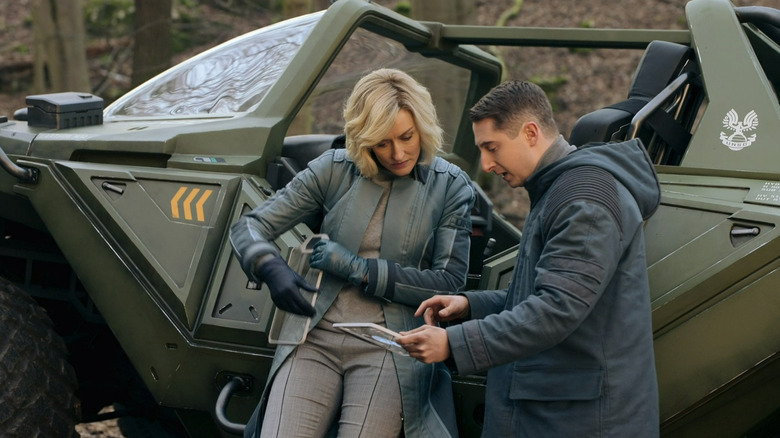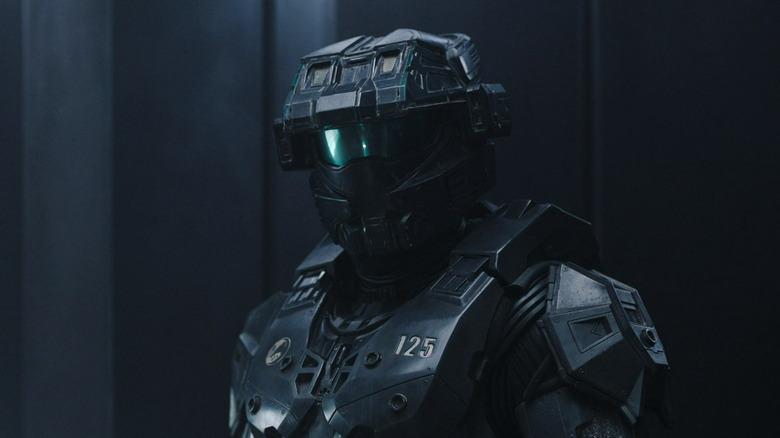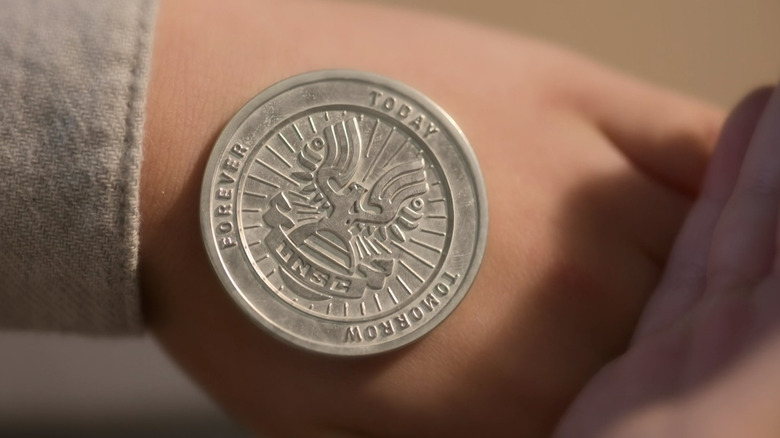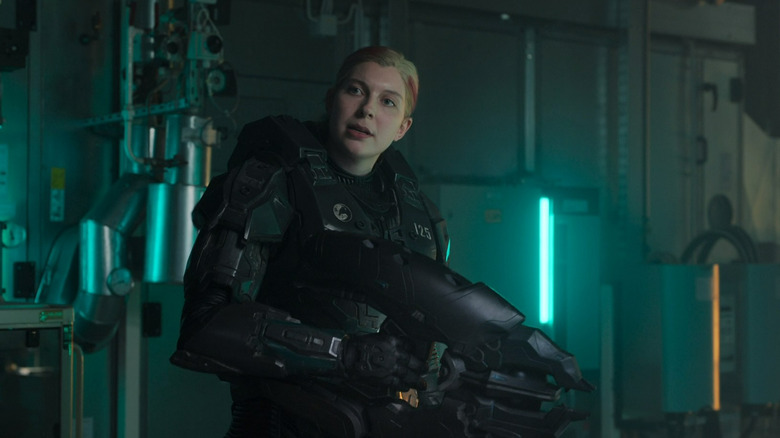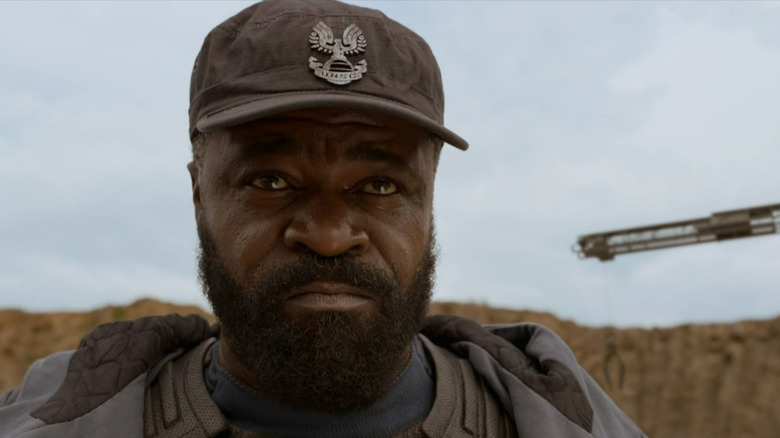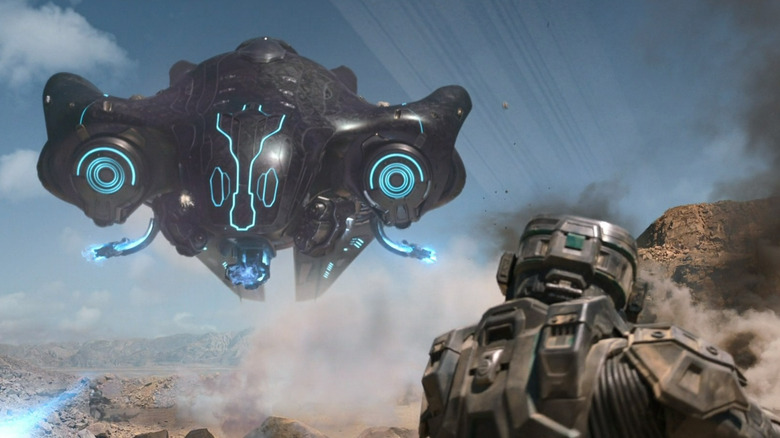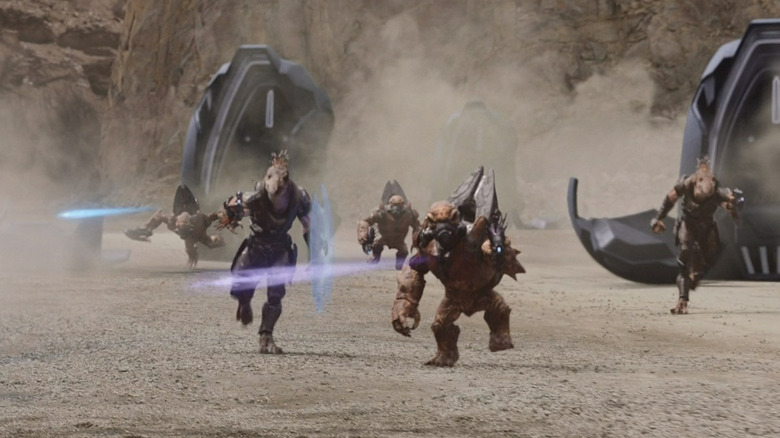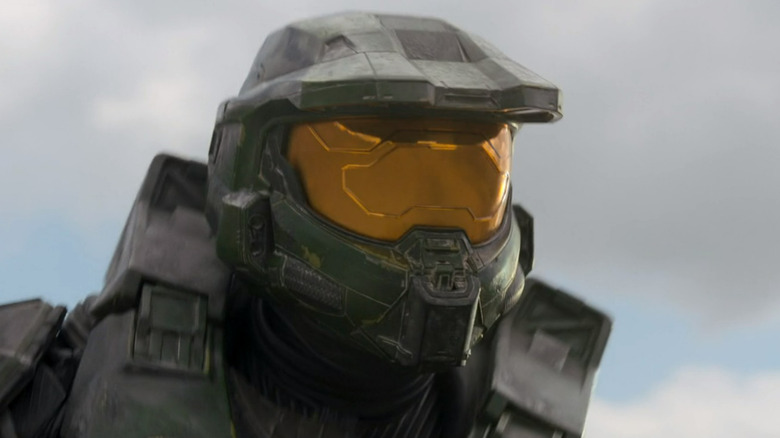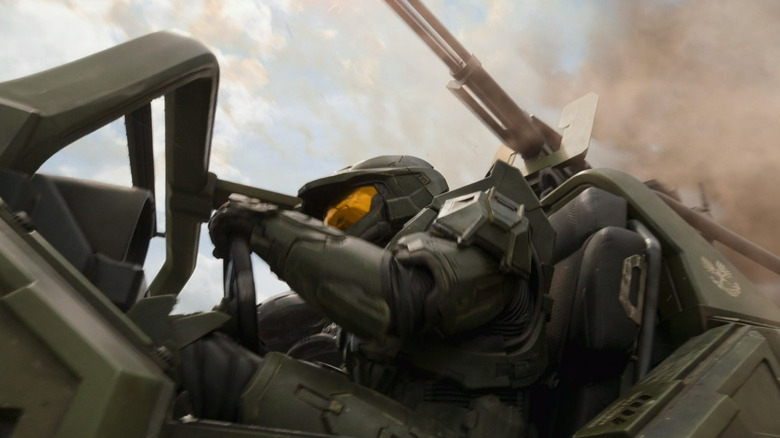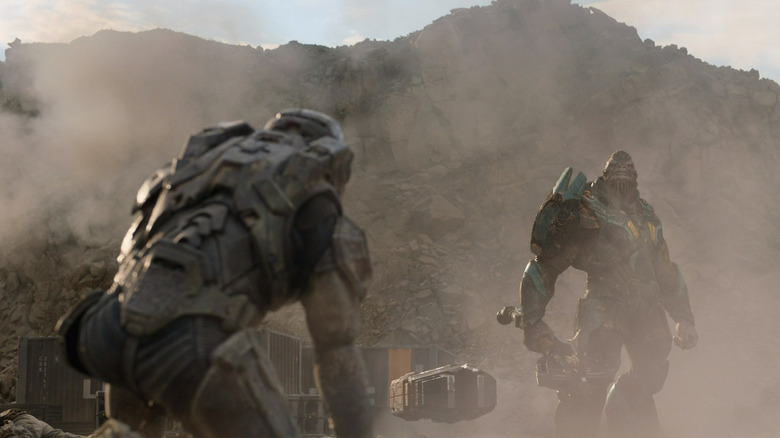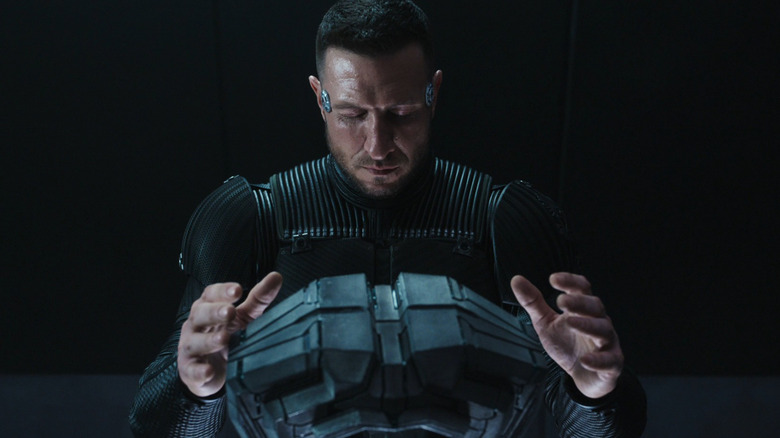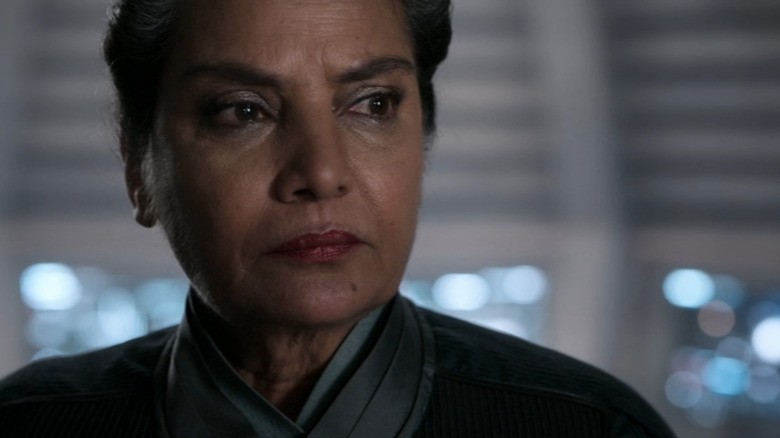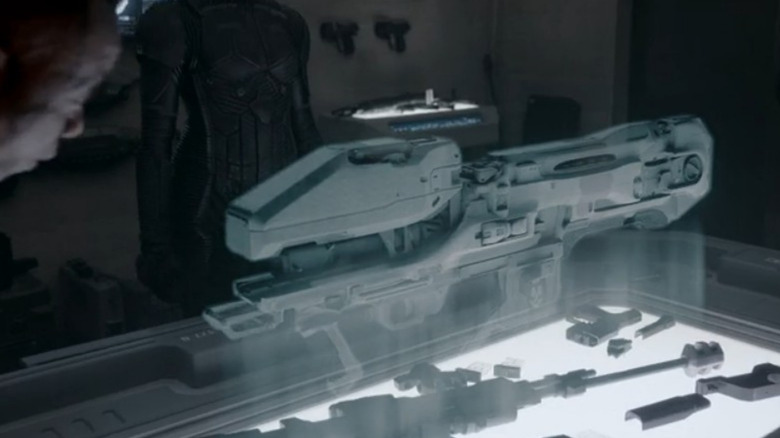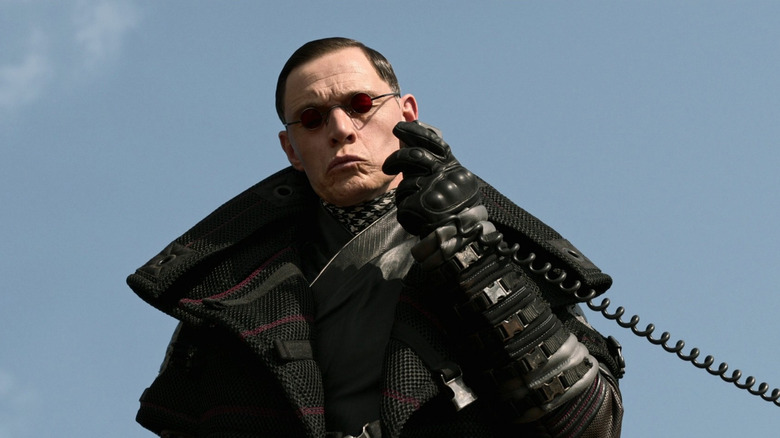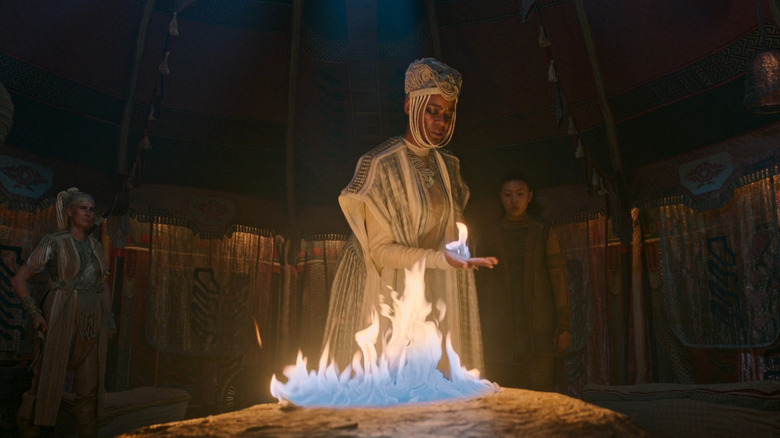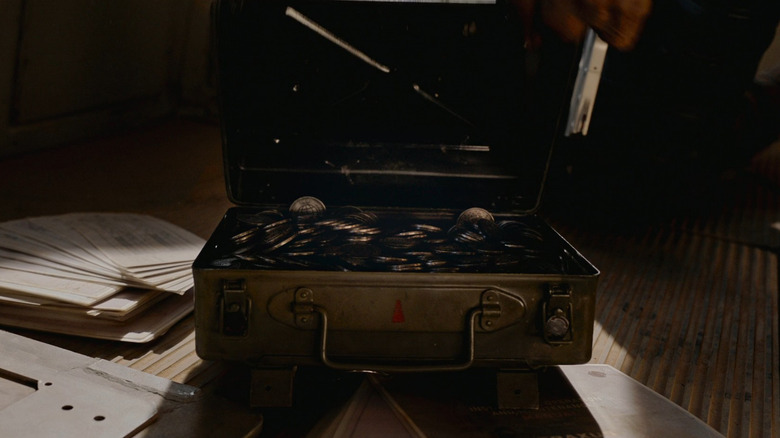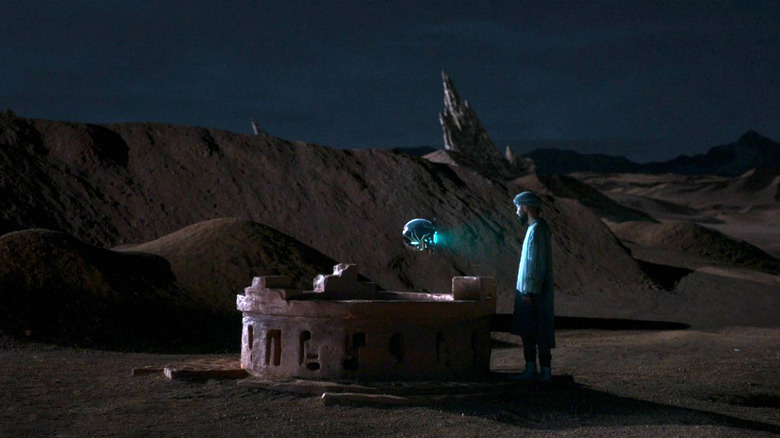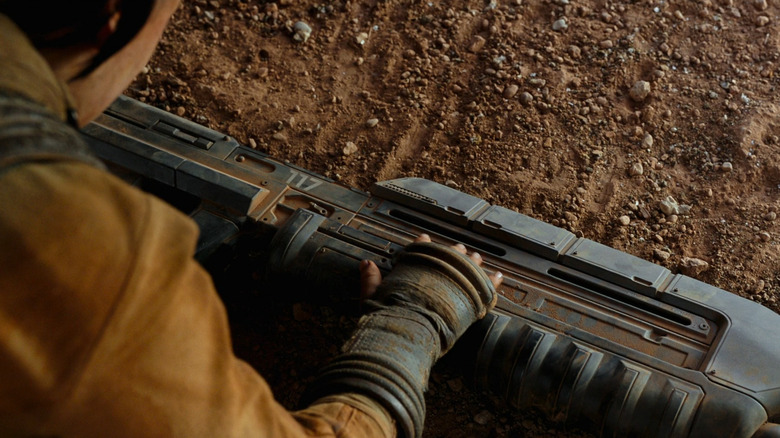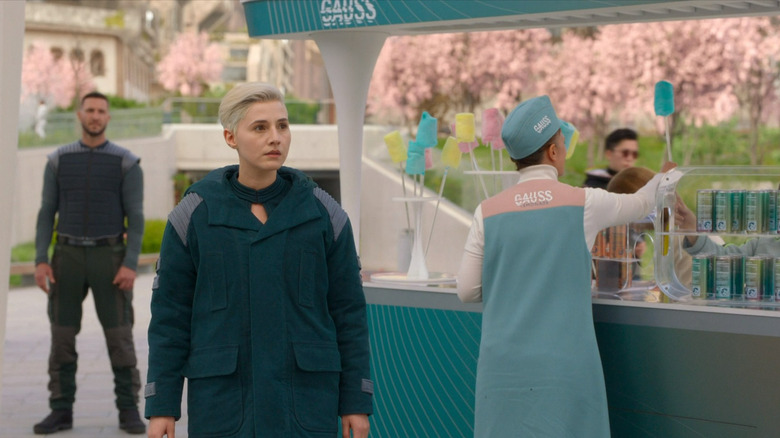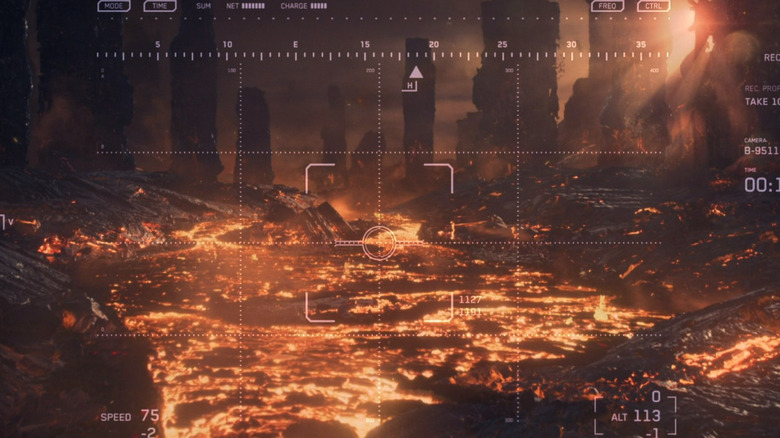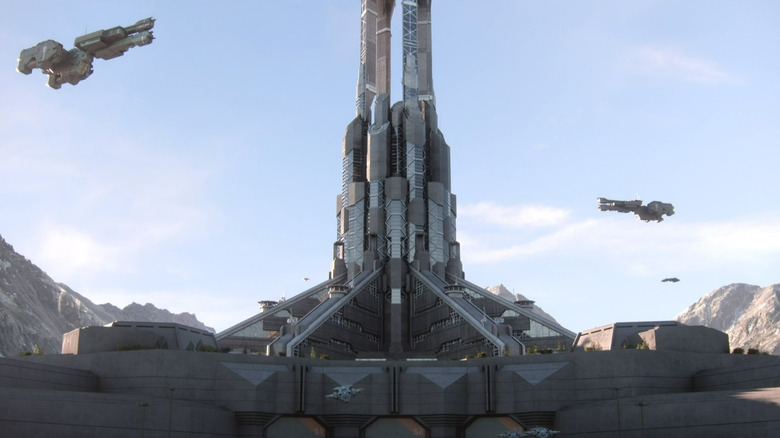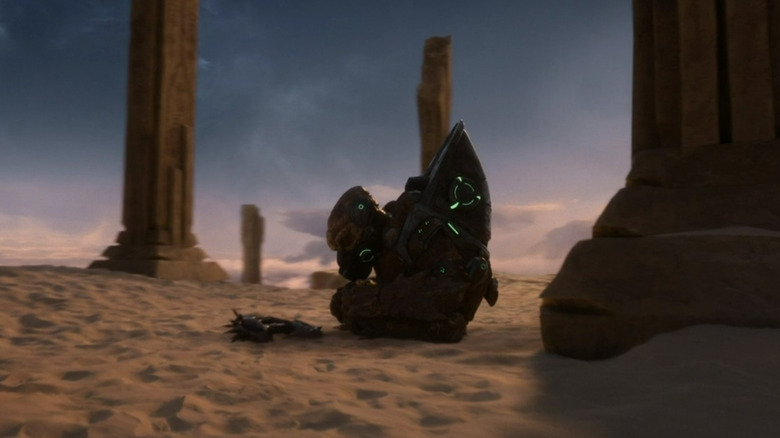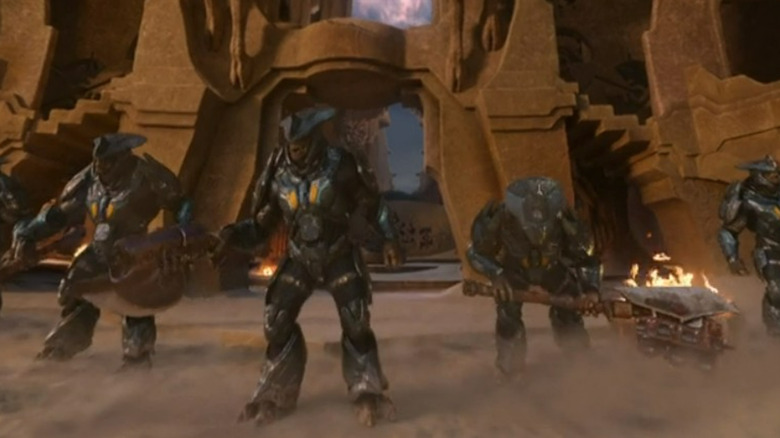Easter Eggs You Missed In Halo
The long-awaited "Halo" series has arrived on Paramount+, bringing one of the most popular and influential video game franchises ever to the realm of live-action TV. Set in a separate timeline from the previously established canon, the new show takes elements from the games and the "Halo" books, keeping much the same but reworking some events and plot points to adapt the story for its new medium. As many fans can attest, making a video game adaptation is hard, and history is littered with failed attempts and disappointments. Fortunately, "Halo" has avoided the worst of that fate so far, earning solid reviews overall and striking a good balance between new viewers and longtime fans.
Though it exists in a separate continuity from the games, "Halo" takes a lot directly from its source material. From the design of classic vehicles like Warthogs and Banshees to the look of Master Chief's Mjolnir Mark VI armor, most of the production design comes straight from the games. There's also immense loyalty when it comes to the main characters, with familiar faces like Catherine Halsey and Jakob and Miranda Keyes all playing big roles. And of course, many of the series' broad narrative strokes are recreated in the show as well — things like the nature of the Spartan program, the Covenant hierarchy, the UNSC facilities on planet Reach, and the looming influence of the mysteries Forerunners.
Some of the ways "Halo" pays homage to its source material are less obvious, however. From combat tactics to planet names and audio cues, there are a lot of little details that may go over the heads of those not intimately familiar with the franchise. Read on to discover some of the big "Halo" Easter eggs you may have missed on your first watch.
Madrigal
"Halo" starts out on the planet Madrigal — one of humanity's outer colonies and a major center for the rebellion against the UNSC. In the opening scenes of the show, Madrigal is shown to be relatively barren, save for occasional mining colonies. This peaceful façade is shattered by a surprise attack by the Covenant, who kill all but one inhabitant of the settlement they target. The Sangheili warriors (more commonly known as "elites" in the games) are in turn dispatched by the UNSC Spartan squad Silver Team, led by the Master Chief (Pablo Schreiber).
Madrigal may not ring any bells for newcomers to the "Halo" franchise, or even for those who've played the games, but the planet does play a significant role in the spinoff novels — particularly Joseph Staten's "Halo: Contact Harvest" and Tobias Buckell's "Halo: The Cole Protocol." In the original canon, Madrigal is one of the first planets to be "glassed" by the covenant — a genocidal act of orbital attack that eliminates all life on a world and renders it essentially uninhabitable. The show's version of Madrigal is a bit different, as it remains un-glassed well into humanity's war with the Covenant. However, with a heavy narrative focus still being placed on the planet, its original fate may eventually catch up with it on Paramount+ as well. Interestingly, Madrigal has its true origins in "Myth," an early game created by "Halo" developer Bungie, in which a prominent city bore the same name.
Covenant technology
The first episode of "Halo" kicks into high gear almost immediately with a fierce battle between Silver Team and the Covenant's Sangheili elites. It's a great way to show off the kind of action fans can expect from the series early on, and it also features a number of specific references to the "Halo" video games. Several of those Easter eggs come in the form of the Covenant's weapons and sci-fi gear, much of which will be instantly recognizable for longtime fans.
While the design of the Sangheili armor is a bit different in the show (one of very few design divergences), their weapons and shields are spot-on, right down to the little details. Anyone who's played the "Halo" games on the higher difficulties of "heroic" or "legendary" will empathize with the Madrigal militia's inability to penetrate the elites' shields — defenses that are heavily resistant to bullets but more susceptible to plasma weapons. The new series does a great job of keeping these qualities of the shields consistent. Another great touch in the Madrigal fight is the plasma pistol — a classic Covenant weapon from the games. When one of the Silver Team Spartans fires a charged shot from the plasma pistol at an enemy Sangheili, a vent on the top of the gun pops open to vent the excess heat, just as it does in the games.
Additionally, the Madrigal fight features incredibly faithful recreations of the energy sword and the elites' active camouflage.
Shields down!
If you thought the "Halo" show would break the trend of awkward first-person sequences in video game adaptations, you'd be wrong. The first episode barely gets 10 minutes deep before the camera jumps inside Master Chief's helmet to show a heads-up display (or HUD) that's very reminiscent of the video games, right down to a radar in the bottom left-hand corner, targeting reticles, and a readout of his currently equipped weapon and available ammunition. It's a bit silly, but that doesn't stop the show from using the HUD view repeatedly through the Madrigal battle.
Although the first-person view itself feels a bit heavy-handed in its callback to the games, there's a more subtle Easter egg incorporated into the scene that only fans of the games will recognize. At one point, Master Chief takes a heavy amount of plasma fire from an attacking Elite, and his HUD shows that his energy shields are temporarily depleted. He quickly ducks behind the nearest available cover to wait for his shields to come back. This isn't just a nod to the mechanics of the "Halo" games — which were some of the first to introduce the concept of regenerating shields instead of a traditional health pack system — it also uses the exact same sound effects for the shields being broken and subsequently coming back. The "Halo" show uses a number of specific audio cues from the games, and the shield noise is sure to flash players back to all the times they had to hide behind cover.
Master Chief's full arsenal
Within just the first action sequence of the "Halo" TV series, Master Chief and his Spartan comrades exhibit a wide array of moves and tactics pulled directly from the video games. Many viewers will recognize the weapons themselves, which include the standard-issue UNSC assault rifle, sniper rifle, handgun, and DMR (designated marksman rifle). But the allusions to the games go further than simply the guns themselves.
The way Master Chief fights on Madrigal is spot-on to the combat flow "Halo" players know so well. Because of his armor and shields, Master Chief maneuvers pretty freely in the open, only using cover when his defenses are briefly knocked out. He also makes good use of hand grenades and melee attacks — two key pieces of the so-called "combat puzzle" that's always made the gameplay in "Halo" so engaging. One specific sequence has Master Chief toss a grenade at a group of elites, use it as cover to move in close, and deliver some brutal physical blows with the butt of his rifle that batter down the enemy's shields. It's an approach anyone who's played the games will be familiar with, though using it against a pair of elites with energy swords — which Master Chief does in the show — would be ill advised on an Xbox.
To top it off, Master Chief picks up a fallen minigun dislodged from its mount and wields it like it's nothing — a specific reference to a mechanic implemented in "Halo 3."
The Marathon logo
In their investigation of the Covenant ship on Madrigal, Master Chief and Silver Team happen upon an excavation site and a mysterious artifact at its center. The device turns out to be a "keystone" — a relic from the ancient Forerunner race with ties to the mythical and deadly Halo rings. All of this lore, only alluded to in the show's first episode, harkens back to the games in interesting ways, but there's a specific Easter egg mixed into the scene that only eagle-eyed viewers will catch.
When Master Chief first activates the keystone by touching it, a symbol appears: A relatively nondescript circle within a circle. This symbol is actually the logo for the video game "Marathon," another property developed by Bungie in the years before the release of "Halo." There are a ton of "Marathon" references throughout the whole "Halo" series, and the logo itself appears numerous times, especially in connection to Forerunner technology.
Curiously, "Marathon" features many narrative similarities with "Halo" and can be seen in some ways as an elaborate prototype for the franchise. Themes like human colonization of space, alien wars, and rogue AI all play into the "Marathon" story, just as they do in "Halo."
High Charity
One of the more interesting parts of the "Halo" show is that it features scenes from the Covenant side of the war as early as the first episode. These scenes take place on High Charity, the massive spaceship/planetoid that serves as the capital of the alien force. High Charity appears prominently in the "Halo" games, as do the Prophets — the enigmatic race of older, wizened spacefarers who lead the Covenant forces. The show's version of the vessel is pretty much an exact match to the High Charity of the games — a bulbous, mushroom-like structure of the Covenant's signature purple.
The "Halo" scenes aboard High Charity include a number of smaller Easter eggs for game fans as well, such as references to the "Great Journey" — the core belief of the Covenant religion, which is tied to the Halo rings — and specific characters like the Prophet of Mercy and the Prophet of Truth.
A major change in the Paramount+ "Halo" series is the human character Makee (Charlie Murphy), who appears to be a genuine ally of the Covenant. A denizen of High Charity and a close confidant of the Prophets, Makee is referred to as "Blessed One" and seems to be highly respected. That respect is due to her ability to activate Forerunner artifacts like Master Chief is shown to do. In the games, only some humans (referred to as "Reclaimers") are able to interface with Forerunner technology in this way, but the Covenant never willingly accepted such a human into their ranks.
Musical memories
The "Halo" soundtrack is one of the best parts of the entire franchise. That might seem like a bold claim, given how influential the series has been in the realms of AI, gameplay mechanics, and online multiplayer, but it's a testament to original composer Martin O'Donnell (and his later collaborator Michael Salvatori) that the score holds up alongside all those other accomplishments. The "Halo" series is scored by Sean Callery ("Homeland," "Jessica Jones"), who does a great job with his original compositions. Fortunately, though, "Halo" still includes bits and pieces of the original O'Donnell soundtrack.
In particular, the original "Halo" theme is reprised a couple of times, such as in a few moments tied to the Forerunner keystone in the first episode. These snatches are brief, merely teasing the full piece sure to be heard later in the series, but they're still great homages to the games. With luck, we'll get to hear some other favorite selections from O'Donnell's score as the show continues.
Soren-066
The second episode of "Halo" starts with a flashback to Master Chief's youth. Just a recruit in Dr. Halsey's Spartan program, the young John is shown confronting one of his close friends — another Spartan trainee by the name of Soren — who's trying to escape Reach. It's revealed that John originally planned to leave with him, but he can't go through with the desertion in the end. He gives his friend a five-minute head start, and then he alerts the whole base.
He may not appear in the video games, but Soren-066, as he's dubbed by the UNSC, does appear in the short story collection "Halo: Evolutions." Specifically, he's the main character of a story titled "Pariah," which follows him from a brutal outer colony upbringing through a youth spent being experimented on by Dr. Halsey. Like in the show, Soren's body reacts negatively to the Spartan augmentations, leaving his body deformed. And like in the show, he eventually chooses to defect.
"Halo: Evolutions" never confirms what happens to Soren after being shot down by the UNSC during his escape attempt. The show, on the other hand, builds a whole new lore for him, revealing that he actually managed to get away and eventually built a life for himself away from prying eyes. Actor Bokeem Woodbine does a great job as Soren in the live-action series, and it should be interesting to see where the show takes him.
Familiar faces at the UNSC
Many of the returning characters in "Halo" make their game connections obvious. Players will quickly recall Dr. Catherine Halsey, Captain Jacob Keyes, Miranda Keyes, and of course Master Chief himself. However, there are a couple of characters in the UNSC who may not be recognized by most viewers.
One of these characters is Admiral Margaret Parangosky (Shabana Azmi), Dr. Halsey's direct superior. Parangosky has her origins in the "Halo" books, but she appears in a few of the games as well, particularly in "Halo 4." Her role in the TV series as the director of ONI (the UNSC's Office of Naval Intelligence) is a position she also held in the original canon.
Easier to miss is Lord Hood, one of the highest-ranking officers of the UNSC, who first appears in a conversation with Dr. Halsey in the second episode of "Halo." While he isn't named in the episode, shots in a subsequent counsel meeting scene show that he wears a nametag with "Hood" written on it. The character is voiced by noted Hollywood talent and "Hellboy" star Ron Perlman in the video games, but in the Paramount+ series, Hood is played by veteran actor Keir Dullea.
The Rubble
After disobeying UNSC orders and going rogue, Master Chief takes Kwan Ha Boo (Yerin Ha) to the one place he believes she'll be safe — the Rubble. A renegade human colony built into an amalgam of asteroids, the Rubble appears most prominently in the novel "Halo: The Cole Protocol." In the book, many of the Rubble's inhabitants are refugees from Madrigal, which seems to be referenced in the show by Kwan's arrival there.
However, there are a lot of differences between the Rubble of the old "Halo" canon and the version shown in the Paramount+ show. For starters, in "The Cole Protocol," the Rubble isn't just inhabited by humans, but also by Kig-Yar — one of the member species of the Covenant commonly referred to as "jackals" in the games. Secondly, the colony in the book is largely operated by an AI called Juliana, who doesn't appear to be part of the new canon. Lastly and perhaps most significantly, the Rubble is ultimately destroyed by the Covenant in the books, forcing its residents to flee.
The Kig-Yar plotline and the eventual destruction of the Rubble could eventually take place in the "Halo" series as well, but that remains to be seen. For now, the colony has provided a fun aesthetic respite from the harsh steel facades of the UNSC worlds.
Reth
After reuniting with his old friend Soren on the Rubble, Master Chief is introduced to a man named Reth — a human who was driven mad after being imprisoned by the Covenant. It's implied that Reth was experimented on and possibly even tortured, all as part of the Covenant's mission to discover and utilize Forerunner artifacts. He even mentions "the ring" specifically. Though he doesn't call it a Halo, he clearly understands that it's a weapon of genocidal proportions.
What most viewers might not know is that Reth is actually a reference to the novel "Halo: The Cole Protocol." In the book, Reth is the name of one of the leaders of the Kig-Yar, aka jackals, who engage in trading operations with the humans of the Rubble. He's a treacherous and scheming Covenant commander who ultimately causes problems for both factions, and it's certainly an interesting choice to name a human after him in the Paramount+ show. Reth could simply be an Easter egg for fans who've read the "Halo" books, but his name could also foreshadow a larger and darker role in the episodes to come.
UNSC Stalwart Dawn
At the end of "Halo" Episode 2, when Master Chief turns himself back in to the UNSC, there's a brief glimpse and mention of a frigate called the Stalwart Dawn, which transports him back to Reach. This ship is pulled directly from the previously established Halo canon, where it was also stationed on Reach. Fans of "Halo 3" may also notice a similarity in the ship's name to the Charon-class light frigate Forward Unto Dawn.
In the video game "Halo: Reach," the UNSC Stalwart Dawn takes part in the defense of the eponymous planet from a surprise attack by the Covenant. Those who've played the games know that things don't end too well for any of the humans on Reach after that, and the inclusion of the Stalwart Dawn could be an intentional foreshadowing of things to come in the show. The Fall of Reach is one of the most important events in the entire "Halo" timeline, after all, so it seems inevitable that it will be brought to live action on Paramount+ eventually.
Planet Oban
The third episode of "Halo," titled "Emergence," begins in a flashback on the planet Oban, which is described in a caption as a "UEG Tier 2 Waste Salvage Colony." The planet is portrayed as a hellish wasteland of trash piles and smog, where lower-class humans are forced into brutal slave labor by agents of the United Earth Government. While this particular characterization of Oban is new, the planet's name is pulled directly from "Halo 4."
In the wake of the first Human-Covenant War (which ends in "Halo 3"), Oban became a primary hub for resettling human refugees. Unlike the Oban shown in the "Halo" TV series, the planet in the video games is lush and ecologically similar to Earth. Unfortunately, the peace on Oban is ultimately shattered by an attack from the Covenant remnant forces. It seems unlikely that the Oban of the Paramount+ show will share many similarities with its namesake beyond the name itself, but it's still a fun reference.
The Oban scenes also show Covenant Elites carrying a device that they refer to as a Luminary, which is used to locate Forerunner artifacts. While the design differs a bit in the show, Luminaries are indeed part of the Covenant's arsenal in the "Halo" games.
Cortana's origins
Much of "Halo" Episode 3 is devoted to the creation of and early operations of Cortana, the AI created by Dr. Catherine Halsey to be Master Chief's stalwart companion. Fans of the games (and anyone with a modern Windows device) will already be intimately familiar with Cortana, but they may not all be familiar with the process that led to her creation. The "Halo" series stays pretty loyal to the original canon when it comes to Cortana's origins — a process that revolves around the illegal practice of flash cloning.
Just like in the show, the "Halo" books detail flash cloning as a method of rapidly growing human organs from DNA samples. The process can also be used to clone an entire human, as Halsey does (in violation of UEG law). In both the series and the games, she uses a digitized version of her own cloned brain as the basis for the Cortana construct — but that's not where the Cortana Easter eggs stop.
Cortana's first words
Jen Taylor, the voice actor who plays Cortana in the "Halo" video games, returns to voice her in the Paramount+ series as well. Diehard fans may recognize the first phrase she utters upon materializing: "When the game is over, the king and the pawn go back into the same box." This line is a translation of an old Italian proverb that's associated with Dr. Halsey's mother in the books and games — something she said to her daughter while teaching her to play chess. It's Cortana's first spoken phrase in the original canon, so it's only right that it fills the same role in the Paramount+ series.
Technically, though, this isn't the first famous Cortana line uttered in the "Halo" show. Episode 1, "Contact," includes one of the character's best-remembered and most heavily memed quotes from "Halo: Combat Evolved": "This cave is not a natural formation." In the game, Cortana makes the statement about an obviously constructed Forerunner structure. In the series, the line is spoken by one of the Silver Team Spartans when they discover the Forerunner artifacts being excavated on Madrigal.
Covenant Hunters
In response to the UNSC acquiring the Forerunner keystone from Madrigal, the Covenant Prophets sends an agent of their own to take it back — Makee, the human Reclaimer who defected from the UEG after witnessing their immense cruelty. She takes a Covenant corvette and sneaks aboard an unsuspecting UNSC ship by using a fake distress call, but she isn't alone when she boards the vessel. She's accompanied by one of the Covenant's most dangerous assets: The Lekgolo.
Lekgolo are massive alien worms capable of combining with one another to form hivemind-esque super-beings. In the "Halo" video games, they most commonly appear in the form of Mgalekgolo, called Hunters by the UNSC. Hunters appear to be independent, bipedal warriors, but in reality they are simply massive suits of power armor inhabited and controlled by small colonies of Lekgolo.
Makee takes over the UNSC Gladius with a swarm of unarmored Lekgolo, who quickly overwhelm all human forces stationed on the spacecraft. Before she boards, however, there is a brief shot of a proper Hunter from behind. Only one leg and part of its weaponized arm are visible, but the shot effectively sets up the arrival of proper Hunters later in the "Halo" series.
The Cole Protocol
Though Makee makes short work of the UNSC Gladius' crew, she isn't quite quick enough to stop the ship's captain from wiping all sensitive records from the computer system. Just before she kills him (with what appears to be a tiny energy sword of sorts embedded in her fingernail), he tells the ship to activate "the Cole Protocol" — a phrase any fan of the "Halo" novels will be familiar with, as it's the title of one of the series' most famous books.
The Cole Protocol, named for UNSC Admiral Preston Cole, is a directive meant to keep the location of Earth and all related information out of the hands of the Covenant. By invoking it before his death, the captain of the Gladius blocks Makee from accessing any truly sensitive data from the ship. The Paramount+ show even goes so far as to include the Cole Protocol's exact ordinance number on the Gladius' computer screen: Emergency Priority Order 098831A-1. It's a fun little detail that shows just how much the series' writers have paid attention to the source material.
Forward Unto Dawn
The "Halo" show is clear from the get-go that the UNSC is an authoritarian military power, which dips dangerously close to outright fascism on many occasions. The organization's higher-ups have no qualms about killing innocents, abducting children, or conducting all other manner of reprehensible deeds in the name of order and dominance. The UNSC facilities on Reach include several phrases plastered around the walls that reflect humanity's military-centric society, some of which are pulled directly from previous "Halo" media.
One such phrase appears behind Dr. Halsey while she's conducting experiments on the Forerunner keystone — the phrase, "Together We Prevail." Those words are part of a famous poem in the original "Halo" canon called "Forward Unto Dawn," which is also the namesake of a UNSC ship in "Halo 3." "Through Knowledge, Victory. Through Unity, Peace," the piece begins. "Honor, Valor, Allegiance. Today. Tomorrow. Forever. Together We Rise. Together We Prevail. Forward Unto Dawn." Last but not least, "Forward Unto Dawn" is also the name of the live-action miniseries produced during the lead-up to the release of "Halo 4."
Another reference to prior "Halo" media in the Reach facilities appears in the Silver Team barracks — the phrase "Per Mare, Per Terras, Per Constellatum." Translated, it reads, "By sea, by land, by the stars." In the original canon, this is one of the chief mottos of the UNSC.
Hesiod, Metisette, and Eridanus II
The third episode of "Halo" references a number of locations from the original series canon. Two of these allusions come in a scene on the Rubble, in which Soren's son shows Kwan the gas giant Hesiod and its smaller moon Metisette, where he says people don't go because there's no air. Both of these celestial bodies are tied to the Rubble in the "Halo" novels, where Metisette's inhospitable atmosphere ends up causing some serious problems for humanity. A Covenant faction uses the atmospheric conditions of the moon to quickly grow an attack force of Unggoy, also called Grunts. It seems that the "Halo" TV series may be foreshadowing a similar event.
At the end of Episode 3, there's also a major reference to the planet Eridanus II — Master Chief's homeworld. This is consistent with the lore of the games and the novels, but the nature of the planet seems to have been changed significantly. Originally, Eridanus II was a thriving and heavily populated world with several major urban centers. In the Paramount+ show, it's changed to be a colony world wiped clean of human habitation by a deadly plague.
The Spartan kidnappings
The "Halo" show explores one of the darker aspects of the franchise's lore that's only loosely alluded to in the games — how most of the candidates for the UNSC's Spartan-II program were kidnapped as children on Dr. Halsey's orders. After interacting with the Forerunner keystone, Master Chief begins to have flashbacks to his childhood. In "Halo" Episode 4, there are scenes that show him being trained by the UNSC and conditioned by Halsey as a young boy.
In the original "Halo" lore, abduction was also the means through which Halsey "recruited" her Spartans. She used genetic data gathered from humanity's various interstellar colonies and analyzed the physical and mental aptitude of her candidates to determine which children would be the best possible subjects for her experiments, then kidnapped them and replaced them with flash clones whose bodies would quickly break down. Obviously, this process was deplorably immoral for multiple reasons. The kids themselves had no say in the matter, both they and their families suffered immense trauma as a result of the operation, and even Dr. Halsey's methods of selection reflect a disturbing belief in eugenics. To top it all off, the Spartan-II program wasn't even originally conceived to battle the Covenant in the original lore. Rather, Halsey proposed the initiative as a means by which to efficiently quell human rebellions and insurrections in the UNSC's outer colonies. It's pretty despicable stuff.
Soren's tragic backstory
From the moment Soren-066 is introduced in the "Halo" TV series, he starts dropping references to his origins in the "Halo: Evolutions" short story collection. While the character is changed in many ways from his equivalent in the book, he shares the same basic story of defecting from the Spartan-II program and being pursued relentlessly by the UNSC as a result. In "Halo" Episode 4, Soren reveals another way in which he pulls from his "Evolutions" story — his tragic and violent relationship with his father.
In the "Evolutions" story "Pariah," which details Soren's life, he's raised on an outer colony world called Dwarka by his mother and stepfather. His mother grows ill from a local disease, but his stepfather is negligent in her care and refuses to take her into town for treatment until it's too late. When Soren discovers his mother's dead body — which is hidden from him at first by his stepfather — he swears revenge and attempts to murder his stepfather with a knife. Since he's still young at the time, the attack fails to kill the man, so Soren instead waits in the forests around their farm until the sickness that took his mother takes his stepfather as well.
From what's said in the Paramount+ show, it's unclear how close Soren's new story is to "Pariah." All he says to Kwan in Episode 4 is that it took him a year after his defection to remember that his father was dead, and another year after that to remember that he killed him. Regardless of the details, though, the "Halo" show is clearly taking a lot of inspiration from "Pariah" when it comes to Soren's past.
Warthog variants
The Warthog is unquestionably the most recognizable of all the "Halo" vehicles, having appeared in one form or another in every game in the franchise. The most common model of Warthog has a minigun mounted in the bed, which a standing marine can operate independently of the driver. These sorts of Warthogs are seen in the Reach scenes of the "Halo" show's early episodes.
In "Halo" Episode 4, another version of the Warthog is shown — one that features an expanded crew bed instead of a mounted weapon. Master Chief, Dr. Catherine Halsey, and her assistant Adun use the vehicle during the expedition to Eridanus II, where they search for Forerunner artifacts from John's past. This larger, less combat-oriented Warthog is drivable in various "Halo" games, and it's one of many less common variants. One of the best things about the Paramount+ series is its loyalty to the games in terms of visual design for weapons, vehicles, and gear, and that stays true with the various Warthogs seen in "Halo."
Preston Cole
During a conversation with Miranda Keyes in "Halo" Episode 4, Kai-125 invokes the name of Preston Cole, a pivotal figure from the original "Halo" novels. Cole is referenced earlier in the show when the Cole Protocol — a directive to keep the location of Earth from the Covenant at all costs — is mentioned, but it's a nice touch for those who've read the books to hear the admiral's full name mentioned.
Cole's life is explored in detail through various "Halo" books and comics, including one of the primary stories in "Halo: Evolutions," the novel "Halo: The Fall of Reach," and the book that bears his name, "Halo: The Cole Protocol." Born on Earth, Preston J. Cole was a major figure in the UNSC's battles with pirates and insurrectionists in the outer colonies. Later, he became the most decorated officer in the war against the Covenant, earning multiple victories including one at the Battle of Harvest — the first human planet conquered by the invaders. Though Cole was eventually believed to have been killed during a particularly dangerous campaign, the lore leaves things open-ended and never confirms his death as a fact.
Given the admiral's legendary status in the UNSC, it makes sense why Kai would mention him as one of the great military strategists whose tactics the Spartans were trained in.
The lucky one
Upon his return to Eridanus II, Master Chief starts having even more vivid flashbacks to his childhood. One of the memories that comes to him is of a young Dr. Halsey playing with him as a boy in his family's kitchen. She gives him a coin emblazoned with the UNSC logos and has him flip it and guess heads or tails. John displays an almost miraculous talent for the game, guessing correctly on 11 straight tosses. Impressed by his prescience, Halsey makes a remake about how lucky John is — a line that may be an intentional reference to the "Halo" games.
Though he clearly possesses a natural predilection for combat tactics, strategy, and leadership — augmented by his Spartan enhancements and training — Master Chief is also described in the games as being incredibly lucky. This observation is probably most famously made by Cortana herself in the opening cutscene of the "Halo 3" campaign, during which she delivers a short monologue about how and why she chose to be paired with John rather than one of the other Spartans. "You had something they didn't," Cortana says. "Something nobody saw but me. Can you guess? Luck."
Of course, in the "Halo" show, Cortana doesn't get to choose her Spartan. She's paired with Master Chief on Dr. Halsey's explicit command. Still, it's nice to see the series paying some form of tribute to John's infamous luck. Part of what makes the Master Chief such a compelling hero, after all, is that not all of his prowess can be quantified.
Miranda Keyes' lab
In "Halo" Episode 4, Miranda Keyes takes the members of Silver Team (excluding Master Chief) into a lab where she analyzes Covenant weapons and technology. The scene is filled with little Easter eggs and references to the games. There are multiple Covenant firearms on display, including a Type-51 Carbine and a Needler, which Kai-125 picks up excitedly and quickly begins explaining. In her discussion of the Needler, she drops a couple explicit references, naming the weapon's explosive effect a "supercombine" — the exact phrase from the games — and describing its aftereffect as a "pink mist" — a reference to a Needler-based achievement in "Halo 3," which itself is a reference to the war movie "Jarhead."
Later in the scene, as the Spartans help Miranda decode the Sangheili language, Kai can also be seen holding a purple plasma grenade. It's one of the two original grenade types that are usable in the original "Halo," and it's the most common such weapon wielded by the Covenant throughout the series. There are a number of other touches from the games in Miranda's lab, such as the cadaver pieces of Sangheili Elites and what appear to be dormant Lekgolo in a tube — the wormlike creatures that combine to form the fearsome Covenant Hunters.
UNSC Pioneer
"Halo" Episode 5, "Reckoning," takes place almost entirely on Master Chief's homeworld of Eridanus II, where Dr. Halsey sets up a temporary camp to examine and excavate the second Forerunner keystone. The main ship in use for the operation is the UNSC Pioneer, and while it barely even appears on screen in the Paramount+ show, that name is pretty important in the "Halo" novels.
In "Halo: The Fall of Reach," the Pioneer is the ship that Master Chief and his Spartan-II compatriots take on a mission to, you guessed it, Eridanus II. In the canon of the books, the planet and its surrounding system are a hotbed of rebel and insurrectionist activity against the UNSC, and John and his team are sent to apprehend a Marine defector operating in the area. The TV series references this rebellious history on Eridanus II during a flashback in which the woman touring Dr. Catherine Halsey and Captain Jacob Keyes around the planet's human colony mentions how "the colonial insurrection touched everyone, even here."
Of course, in the canon of the show, Eridanus II is far less central to the rebellion storyline, but it's interesting to see its original version referenced by the use of the UNSC Pioneer. Halsey and Keyes' false pretenses for visiting the planet are also pulled straight from the old canon, where they posed as a couple to investigate potential Spartans before they ever actually got together.
Covenant warships
The Eridanus II battle in "Halo" Episode 5 debuts quite a few Covenant species and ships not previously seen in the Paramount+ series. The large Phantom dropships and smaller Banshee aircraft are seen in earlier episodes, but they get a lot more screen time in "Reckoning," and they're joined by several other iconic vehicles and weapons.
In the Eridanus II attack, the Covenant deploy onto the ground from their cruiser via drop pods, which are incredibly faithful to their original design seen in the "Halo" video games. Cortana even refers to the small groups of aliens held in the pods as "lances" — the canonical term for a squad of Covenant soldiers.
Later, a different sort of dropship called a Covenant Spirit descends from the main cruiser. The distinct two-pronged design of the ship should be instantly familiar to those who've played either the original "Halo: Combat Evolved" or "Halo Reach," and other variations of the ship appear across the franchise. It's fun to see the show's creators pulling inspiration from so many different corners of the preexisting lore, especially when iconic pieces of tech like the Spirit are recreated with such loyalty and care.
Jackals and Grunts
Prior to "Halo" Episode 5, only the Sangheili Elites, the Prophets, and the Lekgolo are seen representing the Covenant. That all changes during the battle on Eridanus II, which sees Silver Team and the UNSC Marines facing off against a platoon of Kig-Yar (Jackals) and Unggoy (Grunts). In the games, these two species are generally used as lower-level enemies under the command of larger, more tactical Covenant officers. However, as the "Halo" series demonstrates, they can also be fearsome foes in their own right when they have enough numbers on their side.
For the most part, the Paramount+ show stays pretty close to the Grunts and Jackals of the video games. They still primarily use Needlers and Plasma Pistols, and their visual design is loyal in basically every way. There are some notable differences, however. For instance, one of the Jackals on Eridanus II is seen dispatching Marines with a smaller version of an Energy Sword — a weapon typically only used by Elites in the games. That said, there are instances of Kig-Yar wielding similar weapons in some of the "Halo" books, so it's possible that this divergence is itself another reference for diehard fans.
While Grunts and Jackals will never be the most challenging or exciting enemies in "Halo," it's fun to see the show diving deeper into the Covenant ranks and pulling out more recognizable foes for the UNSC to fight.
It's all a game
As you might expect, the "Halo" show makes a lot of winks and nods to its video game origins. Some of these Easter eggs, like Master Chief's shield sound effects and the first-person perspective shots, are direct references to mechanics from the "Halo" games, but some of them point to other popular franchises or moments from gaming history. For instance, in "Halo" Episode 1, a voice can be heard over a UNSC loudspeaker saying, "Commander Shepherd, you are requested at the Skyllian Response Center." In the popular sci-fi game series "Mass Effect" (which, like "Halo," started as an Xbox exclusive), Commander Shepherd is the main character and a military operation known as the Skyllian Blitz is a key part of his backstory.
In "Halo" Episode 4, in the scene where Kai describes how a Needler works, she ends her monologue with the isolated phrase "massive damage." This isn't necessarily a specific reference, but it could be a nod to an infamous moment from E3 involving Microsoft's rival company Sony. Either way, the expression feels like a definite gaming allusion.
During the battle on Eridanus II in "Halo" Episode 5, Cortana encourages Master Chief to "switch to secondary" after his pistol clip runs dry. He angrily tells her that he knows "how the game is played" while pulling out his assault rifle. This is a clear reference to the traditional two-weapon system used by many shooter games (including "Halo"), and it could be read as a specific Easter egg for the "Call of Duty" franchise, where sidearm switching is heavily emphasized.
The vehicle level
Most "Halo" games follow a similar pattern as far as level design goes. There's always a tank level where you drive a UNSC Scorpion, and often a big Warthog escape sequence during the final chapter, and there are always at least one or two bigger vehicle-based levels. "Halo" Episode 5 emulates that last archetype in its climactic battle on Eridanus, in which Master Chief drives a Warthog through Covenant ranks with his fellow Spartans manning the guns. Later on, Chief also manages to jump onto a low-flying Banshee, which he uses to destroy a Phantom dropship.
In both cases, Master Chief effectively hijacks the vehicles from Covenant Soldiers. He kicks a Grunt out of the driver's seat of the Warthog, and he tries his best to disrupt the flight control of the Banshee's pilot after jumping aboard. Hijacking vehicles is a major mechanic in the video games (first introduced in "Halo 2"), and it especially comes into play in the more open vehicle levels where players are constantly jumping from one mode of transport to another.
Brute Chieftains
After fighting his way through lances of Grunts, Jackals, and Banshees in "Halo" Episode 5, Master Chief looks like he's about to get the Forerunner keystone safely into the hands of the UNSC. But just when it seems that all Covenant resistance has been defeated, John comes face-to-face with one of the most dangerous soldiers in the entire alien army: A Brute Chieftain.
Those who've played the games will be intimately familiar with the Brutes (also called Jiralhanae) — ape-like bruisers who serve as lieutenants and frontline muscle for the Covenant. The most dangerous Brutes are classified as Chieftains, and that select group wields a range of particularly powerful weapons. In "Halo" Episode 5, the Chieftain who confronts Master Chief holds the infamous Gravity Hammer — a massive melee weapon that creates powerful shockwaves each time it hits the ground. The Brute quickly bests Master Chief (who grabs a salvaged Jackal energy shield to cushion the blow), uses the gravity effects of his weapon to pull the keystone to him, and returns to his dropship via a Covenant gravity lift (another piece of tech pulled straight from the games).
The Brute Chieftain alone is a fun inclusion for fans of the games, but the way in which he's used can also be interpreted as a separate, more specific Easter egg. In the games, it's easy to get distracted during a firefight and find yourself cornered by a Gravity Hammer-wielding Brute. Most "Halo" players have died that way at least once.
The Demon
Throughout the "Halo" TV show, different members of the Covenant are heard referring to Master Chief as "Demon" — a nickname also heard in the video games. Both the Sangheili and the Prophets on High Charity use that term, and Makee even calls Master Chief "Demon" to his face when she finally meets him in Episode 6.
In the games, Chief is referred to as Demon in both cutscenes and combat. For instance, when the player successfully routs a group of Grunts during a firefight, they'll often run screaming about the Demon and give up trying to fight. The name is also used by tougher Covenant soldiers like the Brutes and Elites, though they're usually less frightened of Master Chief when they use it.
Really, the Demon nickname is a testament to how much Master Chief stands out compared to the other Spartans. All of Dr. Halsey's soldiers received the same augmentations and training, but John rises head and shoulders above the rest. Even the Covenant themselves recognize how exceptional he is on the battlefield, which is why they gave him the title of Demon.
The Aspero System
After conniving her way into UNSC custody in "Halo" Episode 6, Makee tells Master Chief that the Covenant will be taking the second Forerunner Keystone to a planet called Raas Kkhotskha, which is in the Aspero system. Aspero is a name that a few fans may recognize, as it plays a crucial role in a couple of the "Halo" novels.
In the original canon, the Aspero system is home to the planet Hesduros — an old Forerunner colony primarily inhabited by Sangheili in the present-day timeline. More importantly, Hesduros is linked via a portal system to the Forerunner Shield World of Onyx. This connection comes into play a couple of times in the "Halo" books, including in Karen Traviss' "Halo: The Thursday War" and Matt Forbeck's "Halo: Legacy of Onyx."
It seems that the Aspero system of the live-action "Halo" series is a bit different. Raas Kkhotskha doesn't figure into the old lore in any major way, and since the character of Makee is brand new for the show as well, it makes sense that the story is going in a different direction.
Spartan Laser
A brief scene in the middle of "Halo" Episode 6 shows Kai entering a munitions room where her comrades Riz and Vannak are chatting. In the middle of the room, there's a projector showing a digital image of a massive weapon — the M6 Spartan Laser.
In the video games, the Spartan Laser is one of the most powerful weapons usable by players, but it also comes with a downside. To fire the bright red energy blast produced by the weapon, you must first charge it for a few seconds. This caveat makes aiming the shot much more challenging and landing one far more satisfying. The physical design of the weapon is spot-on in the Paramount+ show, but the Easter egg goes a bit deeper by also referencing how the Spartan Laser works.
When Kai first enters the room, Riz is in the middle of asking Vannak how much of the weapons energy cell is used for a full blast, and he says 20 percent. Riz then does the math and says that the M6 would hold "maximum five shots." In the games, this is exactly the case. When the player picks up a fresh Spartan Laser, its ammunition readout is a single bar marked "100." That number drops by 20 with each successive shot, meaning that the gun can only be used five times.
Paradise Lost
In "Halo" Episode 7, "Inheritance," outer colony mobster and all-around villain Vinsher Grath (Burn Gorman) is heard reciting some darkly poetic verses about the planet Madrigal. Though the fuel harvested from within the planet has made him a rich ally to the UNSC, Vinsher clearly doesn't hold much love in his heart for the planet, nor for those who've fought him to defend it, like Kwan Ha and her father. The poetry recited by Vinsher is actually pulled directly from the John Milton classic "Paradise Lost," and that specific selection is of special relevance to the story of "Halo."
In the most literal sense, Vinsher's choice of poem signifies how he views Madrigal — as a hellscape he's been unfairly cast down into. The section he quotes details the ordeal of Satan and the other fallen angels of Heaven, who are cast down into the fires of Hell to suffer after rebelling against God. It's curious that Vinsher would choose to self-identify as the devil in this instance, but maybe that's just what bad guys do.
The allusion to "Paradise Lost" can also be read as symbolic to the greater "Halo" story. The general theme of character being cast out of Heaven parallels the Covenant's own "Great Journey" in some ways — a holy mission to fire the Halo rings and achieve enlightenment. On the flip side, the hellish infernos described in the epic poem could be meant to foreshadow the destruction of the rings, which are capable of erasing all sentient life in the "Halo" games.
Dune tripping
After returning to Madrigal in the hopes of reigniting her father's rebellion, Kwan Ha journeys deep into the planet's barren desert and discovers a remote enclave of mystics. She's informed that the group is connected to her ancestors, and that her father learned important secrets from them. In the hopes of following in his footsteps, Kwan undergoes a hallucinatory journey of the mind by ingesting some mysterious water provided by the mystics.
Anyone who's read Frank Herbert's "Dune" or seen any of the live-action adaptations will immediately recognize some inspiration here. The classic sci-fi novel revolves around the remote desert planet of Arrakis, which is valued because of the addictive and mind-altering spice Melange that grows there. Many other movies, shows, video games, and books have pulled elements from "Dune," and the "Halo" series continues that tradition.
There could also be a thematic significance in "Halo" referencing "Dune" so explicitly. Herbert's tale is a story about how blind faith and corrupt institutions can lead to catastrophic violence. Both the Covenant and the UNSC fall into those traps over the course of the "Halo" story.
Real-life science
In "Halo," a lot of fuss is made over deuterium, a hydrogen isotope used to power fusion reactors for both the Covenant and the UNSC. Deuterium is very real, but at this point in history, it hasn't been utilized quite as effectively as in the world of the sci-fi franchise. The fusion reactions that go on within the sun, for instance, heavily involve deuterium. Research into the effective use of deuterium in fusion reaction is ongoing.
In the "Halo" show, deuterium fills the role of oil, or natural gas, or any other vital fuels — a resource over which wars are fought and political alliances are drawn. It's curious to see an isotope that's so incredibly common on Earth be the source of so much industry and effort in "Halo," but that's just a testament to the power of scarcity. Given how much of the technology in "Halo" is entirely fabricated from fictional science, it's interesting to see the bits that feel a bit more attainable in the real world.
The portal and the monitor
Kwan Ha's journey into the Madrigal desert leads her to a curious and exciting revelation: There's a portal within the planet that her ancestors have fought to protect for generations. During her drug-induced dream sequence, Kwan glimpses a well dug by one of her forefathers, out of which flies a small robotic being. Those who've played the "Halo" games will instantly recognize the creature as a monitor — an autonomous machine created by the Forerunners to oversee and protect their various installations.
The most famous monitor in the "Halo" video games is 343 Guilty Spark, a deceptive character who at different points serves as both friend and foe to the Master Chief. Presumably, the monitor seen in the Paramount+ series journeys to Madrigal through the portal within the planet, which may connect it to one of the Halo rings. Forerunner portals of this kind also have precedent in the "Halo" games and books, and there have been multiple instances of important locations being linked with such technology.
Protectors
After completing her vision quest, Kwan Ha is informed that she is a "protector" — someone called to defend the secrets of Madrigal. The particular word used is interesting because in the "Halo" games, "protector" is a subset of the Forerunner Sentinel robots that guard the Halo rings and other similar installations. Because of the Madrigal portal's connection to the Forerunners, this could be an intentional nod to the games, bringing the humans who guard the portal under the same banner as the Sentinels themselves.
Either way, Kwan quickly proves her salt as a protector by taking down Vinsher Grath and a whole squadron of his men. She scores one particularly gruesome kill in classic "Halo" fashion by "sticking" a Covenant plasma grenade to the back of one of her enemies. Just like in the games, a stuck plasma grenade proves to be an instant kill, and the soldier goes up in a cloud of purple haze.
Gauss Lemonade
One of the sillier Easter eggs of "Halo" Season 1 comes early in Episode 8, "Allegiance," when Master Chief and Makee go for a walk in the park on Reach. While out and about, the two stop to chat in front of an unassuming lemonade stand where children and their families are lining up for some refreshing beverages. The logo on the employee's uniform and the stand itself advertises "Gauss Lemonade."
If you've played the later "Halo" games, you may recognize the brand name. "Halo 5: Guardians" and "Halo Infinite" both feature references to a fictional canned drink called Gauss, which uses slogans in its advertisements like "Drink like a Spartan" and "Kick your tongue in the face." The name of the drink seems to be a reference to the Gauss rifle, itself named for famed physicist Carl Friedrich Gauss, which is a commonly seen mounted weapon on Warthogs in the "Halo" games.
Sparkling like glass
While talking to Master Chief in "Allegiance," Makee quotes a bit of an ancient Covenant prophecy pertaining to the supposed Great Journey. "When the stars sparkle like glass, a divine wind will rush through, propelling all those who are worthy on a great journey to the sacred ring, where we will become like gods," she recites. The verse references a brutal Covenant war tactic that comes into play later in the episode — glassing.
In the "Halo" games, glassing is the term used for the alien army's genocidal attacks on planets, where powerful energy weapons are used to melt everything on the surface. Shortly after Makee invokes the term, the UNSC is brought face-to-face with just such an attack. The glassed planet is revealed to be none other than Criterion, a human colony from the "Halo" books. In the original version of the story, the planet is defended by the UNSC in a full-scale battle. Unfortunately, Criterion isn't so lucky in the Paramount+ series.
Admiral Whitcomb
After seeing the decimation wrought by the Covenant on Criterion, Admiral Margaret Parangosky urgently requests that someone named Admiral Whitcomb be contacted in an effort to launch a counterattack. That plan is vetoed by Captain Jacob Keyes, who keeps Admiral Whitcomb off the screen, but those who've read "Halo: First Strike" or "Halo: Ghosts of Onyx" may recognize the name.
Admiral Danforth Whitcomb is a prominent character in the "First Strike" novel in particular, where his many military exploits and successful missions against the Covenant are detailed. He was involved in the Fall of Reach, as well as in the Battle of New Constantinople and the Siege of the Atlas Moons. Whitcomb was one of the highest-ranking and most decorated officers in the UNSC during the Human-Covenant War, and it's fun to see him getting a little shoutout in the live-action "Halo" show. The Paramount+ series has pulled from all corners of the franchise lore to fill out its alternate timeline, giving a richer texture for those familiar with the games and the books.
The sleeping Grunts
In the final episode of "Halo" Season 1, Master Chief leads Silver Team on a dangerous mission to the Covenant's holy planet, where Makee and the Prophets are preparing to unite the two keystones and signal a path to the Halo ring. What follows is an extended action sequence, which begins when Chief leads his squad in an orbital drop from their ship down to the planet's surface.
The camera then jumps to the ground, where a Covenant Grunt is snoozing on guard duty. His nap ends up being the death of him, as Master Chief crashes into him from the sky before the Grunt can even wake and notice. In the "Halo" games, sleeping Grunts are a common sight. Many levels feature whole squads of the little guys napping frighteningly close to a combat zone. "Halo" Episode 9 also features an additional Easter egg from these classic "Halo" enemies which can be heard after the Covenant forces become aware of the Spartans' presence. Another Grunt runs to warn the Prophets by shouting about the "Demon" — a word that foes in the games often shout while running for their lives as Master Chief chases after.
Zealots and Brutes
Master Chief's battle to procure the Forerunner keystones in the Season 1 finale of "Halo" pits him and the rest of the Silver Team against a mighty Covenant force. When the Prophets discover the humans' invasion, they summon the Zealots — a subset of Sangheili Elites that fans of the games will be well acquainted with. However, the Zealots of the Paramount+ "Halo" series are quite different than those found in the source material.
Historically, Zealots have been the most elite of the Elites — commanders and leaders equipped with powerful weapons and armor. The ceremonial guard who performs the keystone ceremony looks more like those original Zealots than the Elites who emerge in hordes to fight the Spartans, but it's the latter who are referred to as Zealots in the show.
In addition to the Elites, Silver Team is confronted by a squad of Covenant Brutes, including the Chieftain who previously fought Chief in "Halo" Episode 5. That particular Brute still wields the fearsome gravity hammer as his weapon of choice, but other brutes are also shown wielding Spikers — a deadly rapid-fire weapon used by the Brutes in the "Halo" games.

